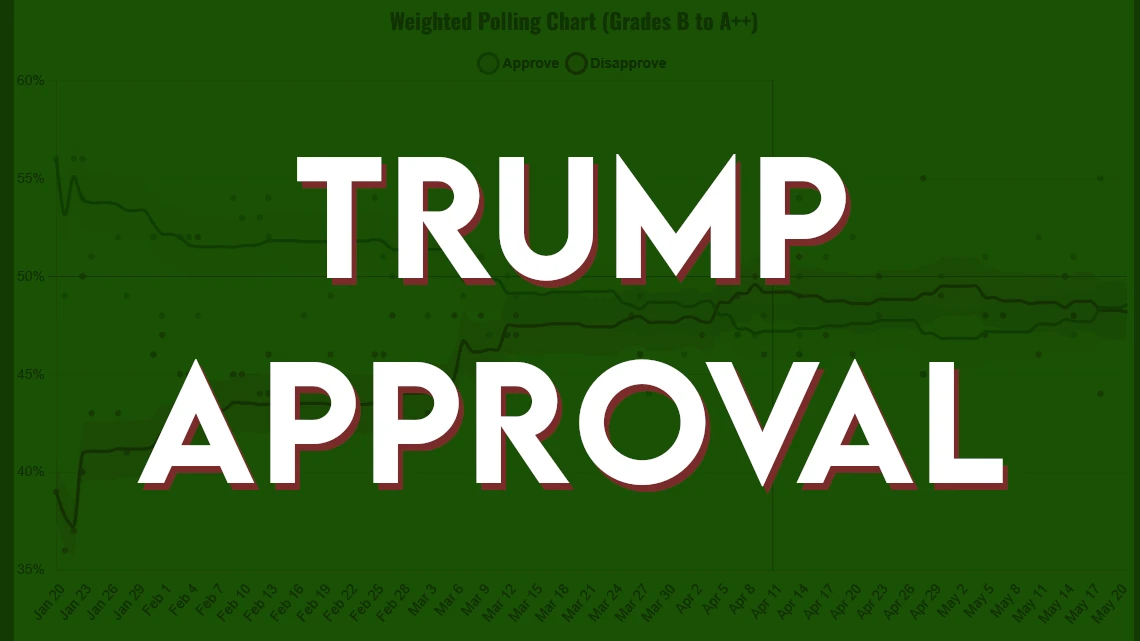
Published on
Written by Mark Christian
President Donald Trump’s approval rating has returned to positive territory, according to our Polling Aggregate, rebounding from a dip in early April 2025 following his controversial "Liberation Day" tariff announcement. This recovery, also reflected in other major polling aggregates, has sparked questions among liberals about the causes and among conservatives about its sustainability. The data suggests this resurgence is not only possible but likely to persist, driven by improving economic indicators and foreign policy successes.
Trump’s approval initially peaked at +17 in early 2025, benefiting from a post-inauguration grace period—a phenomenon common to new presidents but notable for Trump given his historically low approval ratings at the end of his first term in 2021. This grace period, lasting nearly three months, was remarkable for a figure as polarizing as Trump, reflecting significant shifts in public sentiment between 2021 and 2024. However, his approval fell to +4 by early March and turned negative by April 5, driven by widespread economic anxiety following the tariff announcement. Polls from that period showed a majority of Americans believed tariffs would harm the economy in the short term, amplified by stock market volatility and a disappointing GDP report.
The tariff policy, designed to address trade deficits and secure new trade deals, initially fueled fears of a recession, with betting markets predicting a downturn by Q2 2025. Media coverage and expert warnings heightened public concern about inflation and stagflation. Yet, Trump’s strategic pause on most tariffs—except those on China—coupled with successful trade negotiations, stabilized markets and alleviated fears. Contrary to grim forecasts, prices for many goods stabilized or decreased due to lower inflation and improved real wages, restoring public confidence.
Beyond economics, Trump’s foreign policy achievements have bolstered his approval. Progress in stabilizing the Middle East and advancing negotiations to end the Russia-Ukraine war have reassured Americans of global stability under his leadership. Polls show strong approval of his immigration policies, a consistent strength. These developments counter the narrative of chaos, replacing it with one of pragmatic governance.
Can this rebound endure? The evidence suggests yes. The economy, recovering from the challenges of the Biden administration, benefits from increasing real purchasing power and a robust stock market. Trump’s proposed tax cuts, including no taxes on tips and Social Security benefits, resonate with working-class voters, while his tariff adjustments demonstrate responsiveness to public concerns. If these trends continue—coupled with potential resolutions to global conflicts and ongoing immigration reforms, such as mass deportations—Trump’s approval could remain stable or improve, setting a strong foundation for the GOP in the 2026 midterms.
The Republican Party must capitalize on this moment. A strong economy, a safer world, and effective immigration policies align with the priorities of the American electorate. Failure to sustain these gains risks alienating the base that propelled Trump to victory in 2024. Conversely, continued success could redefine the GOP as the party of the working class, securing its dominance in future elections. The path forward is clear: deliver on economic promises, maintain global stability, and uphold the will of the voters.
Related Articles
About the Author
Mark Christian is a writer and Founder of America First Insight. Follow him on X (formerly Twitter).
Stay Updated
Get the latest updates from America First Insight. Subscribe to our newsletter for more political news and insights!